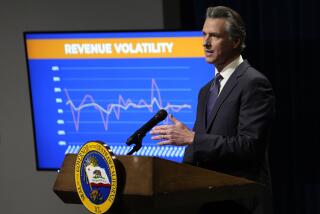Parents, Taxpayers Will Be the Judges of Pricey School Reforms
- Share via
Remember when school was mostly about reading, writing and arithmetic? Nowadays, it has become more complicated by also being about affordability, accessibility and, with the signing of the governor’s teacher incentive bills, accountability.
Since the late 1940s, California’s schools have been forced to rely more and more on state funds. What began as an effort to help poor districts meet basic needs due to the post-World War II enrollment boom gradually developed into a complex and cumbersome process through which schools apply for financial assistance.
This was coupled with the passage of Proposition 13, which further forced schools into even greater dependence on state funds. And with enrollment growth continuing through the 1980s and ‘90s, the approval pipeline is now so clogged that projects are significantly delayed and costs have skyrocketed, much to the detriment of our schools.
The result has been overcrowded classrooms, crumbling schools and a spiraling decline in school performance. After a statewide outcry, California began working its way from under this overwhelming mess. In the early ‘90s, Gov. Pete Wilson began to address school needs with the unprecedented implementation of across-the-board class-size reduction. This was a good first step toward solving the crisis.
*
However, several issues remained. More schools needed to be constructed. Old schools had to be modernized. More teachers were needed, and per-pupil spending needed to increase to at least that of the national average. Recently, Gov. Gray Davis and the state Legislature met the reform goals that the education establishment has claimed will improve our schools. This was highlighted by the signing of the teacher recruitment and education reform package.
These bills appropriate $4.5 billion to recruit and retain teachers by raising their salaries, cutting their taxes for out-of-pocket expenses and improving their retirement benefits. They also increases per-pupil spending to $6,763, a nearly $750 increase. A total of $3.2 billion in education spending will be provided to school districts on a discretionary basis absent state strings.
Although these reforms are a dramatic gesture, it remains to be seen whether spending this much money will fix our education system.
California certainly can afford to make this investment, especially with a $12-billion surplus. However, the true test of the effectiveness of these reforms will be given by parents, who will closely monitor whether their money is being well spent.
Taxpaying parents will be the best judges of our schools’ performance. With the passage of this education reform package, many of the excuses used in the past for poor performing schools have been taken off the table. Those making excuses can no longer claim California schools are underfunded. The increased funding in this year’s budget places California at or beyond the national average in per-pupil spending.
*
California’s teachers are now among the highest paid in the country, and class-size reduction is being fully funded and implemented. Finally, California’s Board of Education has adopted nationally acclaimed standards that, if followed, should prepare our students to compete in the global economy.
There is no longer any reason why our schools should not perform at the level they once did when they were envied across the nation. If, after all of these efforts, school performance fails to improve, parents and taxpayers will react. And react they should. When they realize that it is their $4.5 billion in hard-earned tax dollars being used to improve our schools, you can bet they will have something to say if they feel they are not getting their money’s worth.
More to Read
Sign up for Essential California
The most important California stories and recommendations in your inbox every morning.
You may occasionally receive promotional content from the Los Angeles Times.










